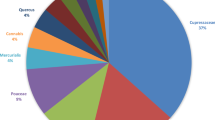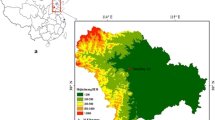Abstract
Purpose
The study investigated the seasonal courses and intradiurnal patterns of birch (Betula), grass (Poaceae), and mugwort (Artemisia) pollen at two sites in the city of Berlin in 2014 and 2015.
Methods
The “Motorway Site” was situated at a busy city motorway and the “City Center Site” on the roof of a large hospital. Sampling was undertaken with 7‑day recording volumetric spore traps. Light microscopic analysis led to daily means (pollen/m3 air) and 2‑h means (daily %). Correlation coefficients were calculated to compare pollen season between the sites. Rainless days were examined for their intradiurnal maximum of pollen concentration and corresponding wind direction in order to identify the impact of local pollen sources. Birch trees, grassed areas, and mugwort/field sagewort stems were mapped at both sites.
Results
The seasonal courses of Betula, Poaceae, and Artemisia pollen each showed significantly positive correlations between the sites, but absolute counts were higher at the motorway. Artemisia pollen showed a distinct morning profile at both sites. Poaceae pollen concentrated on the second half of the day peaking in the evening or at night. Betula pollen offered no clear trend, but the main period mostly started at 8 am and lasted until the end of day.
Conclusions
Higher pollen counts at the motorway seem to be associated with the local vegetation that was much more abundant than at the city center. Local sources of weeds (Artemisia) and grasses (Poaceae) releasing pollen at low heights appear to be more contributing for local pollen load than trees (Betula) at these sites.





Similar content being viewed by others
References
Burbach GJ, Heinzerling LM, Edenharter G, Bachert C, Bindslev-Jensen C, Bonini S, et al. GA2LEN skin test study II: clinical relevance of inhalant allergen sensitizations in Europe. Allergy. 2009;64:1507–15.
Maurer M, Zuberbier T. Undertreatment of rhinitis symptoms in Europe: findings from a cross-sectional questionnaire survey. Allergy. 2007;62(9):1057–63.
Zuberbier T, Lötvall J, Simoens S, Subramanian SV, Church MK. Economic burden of inadequate management of allergic diseases in the European Union: a GA2LEN review. Allergy. 2014;69:1275–9.
Skjøth CA, Ørby PV, Becker T, Geels C, Schlünssen V, Sigsgaard T, et al. Identifying urban sources as cause of elevated grass pollen concentrations using GIS and remote sensing. Biogeosciences. 2013; doi:10.5194/bg-10-541-2013.
Bergmann KC, Zuberbier T, Augustin J, Mücke HG, Straff W. Climate change and pollen allergy: cities and municipalities should take people suffering from pollen allergy into account when planting in public spaces. Allergo J. 2012;21(2):103–7.
Cariñanos P, Sánchez-Mesa JA, Prieto-Baena JC, Lopez A, Guerra F, Moreno C, et al. Pollen allergy related to the area of residence in the city of Córdoba, south-west Spain. J Environ Monit. 2002; doi:10.1039/b205595c.
Gonzalo-Garijo MA, Tormo-Molina R, Muñoz-Rodríguez AF, Silva-Palacios I. Differences in the spatial distribution of airborne pollen concentrations at different urban locations within a city. J Investig Allergol Clin Immunol. 2006;16(1):37–43.
Werchan B, Werchan M, Mücke HG, Gauger U, Simoleit A, Zuberbier T, et al. Spatial distribution of allergenic pollen through a large metropolitan area. Environmental Monitoring and Assessment submitted.
Spieksma FTh M, Corden JM, Detandt M, Millington WM, Nikkels H, Nolard N, et al. Quantitative trends in annual totals of five common airborne pollen types (Betula, Quercus, Poaceae, Urtica, and Artemisia), at five pollen-monitoring stations in western Europe. Aerobiologia (Bologna). 2003;19:171–84.
Ziello C, Sparks TH, Estrella N, Belmonte J, Bergmann KC, Bucher E, et al. Changes to airborne pollen counts across Europe. PLOS ONE. 2012; doi:10.1371/journal.pone.0034076.
Ziska LH, Gebhard DE, Frenz DA, Faulkner S, Singer BD, Straka JG. Cities as harbingers of climate change: common ragweed, urbanization, and public health. J Allergy Clin Immunol. 2003;111(2):290–5.
Behrendt H, Becker WM, Fritzsche C, Sliwa-Tomczok W, Tomczok J, Friedrichs KH, et al. Air pollution and allergy: experimental studies on modulation of allergen release from pollen by air pollutants. Int Arch Allergy Immunol. 1997;113(1–3):69–74.
Sánchez-Mesa JA, Serrano P, Cariñanos P, Prieto-Baena JC, Moreno C, Guerra F, et al. Pollen allergy in Córdoba city: frequency of sensitization and relation with antihistamine sales. J Invest Allergol Clin Immunol. 2005;15(1):50–6.
Cakmak S, Dales RE, Coates F. Does air pollution increase the effect of aeroallergens on hospitalization for asthma? J Allergy Clin Immunol. 2012;129(1):228–31.
D’Amato G, Bergmann KC, Cecchi L, Annesi-Maesano I, Sanduzzi A, Liccardi G, et al. Climate change and air pollution. Effects on pollen allergy and other allergic respiratory diseases. Allergo J Int. 2014;23:17–23.
Bergmann KC, Simoleit A, Wagener S, Mücke HG, Werchan M, Zuberbier T. The distribution of pollen and particulate matter in an urban agglomeration using the city of Berlin as an example. Allergo J. 2013;22(7):471–5.
Statistical Office for Berlin-Brandenburg. 2015. https://www.statistik-berlin-brandenburg.de/publikationen/stat_berichte/2016/SB_A01-07-00_2015m12_BE.pdf. Accessed 12. May 2016.
Hirst JM. An automatic volumetric spore trap. Ann Appl Biol. 1952;39:257–65.
Senate Department for Urban Development and the Environment. 2014. http://www.stadtentwicklung.berlin.de/verkehr/lenkung/vlb/download/verkehrsmengen_2014.pdf. Accessed 12. May 2016.
Simoleit A, Gauger U, Mücke HG, Werchan M, Obstová B, Zuberbier T, et al. Intradiurnal patterns of allergenic airborne pollen near a city motorway in Berlin, Germany. Aerobiologia (Bologna). 2015; doi:10.1007/s10453-015-9390-6.
Hecht R. Pollenbestimmungstechnik, Ergebniswertung und die Herausgabe von Pollenfluginformationen. In: Bergmann KC, Stiftung Deutscher Polleninformationsdienst, editors. 3. Europäisches Pollenflug-Symposium – Bad Lippspringe – Vorträge und Berichte. Düsseldorf: Vereinigte Verlagsanstalten GmbH; 1994. pp. 21–32.
Nilsson S, Persson St. Tree pollen spectra in the Stockholm region (Sweden), 1973–1980. Grana. 1981;20(3):179–82.
Jäger S. Tageszeitliche Verteilung und langjährige Trends bei allergiekompetenten Pollen. Allergologie. 1990;13(5):159–82.
de Weger LA, Bergmann KC, Rantio-Lehtimäki A, Dahl Å, Buters J, Déchamp C, et al. Impact of pollen. In: Sofiev M, Bergmann KC, editors. Allergenic pollen: a review of the production, release, distribution and health impacts. Dordrecht: Springer; 2013. pp. 161–215.
Wachter RKF. Der Gehalt der Luft über mitteleuropäischen Messstellen an Pollen von Artemisia, Plantago und Rumex. München: Dissertations- und Fotodruck Frank oHG; 1978.
von Wahl PG, Puls KE. Pollenemission und Pollenflug von Kräuterpollen. Grana. 1991;30(1):260–4.
Raynor GS, Ogden EC, Hayes JV. Dispersion and deposition of timothy pollen from experimental sources. Agric Meteorol. 1972;9:347–66.
Fuckerieder K. Der Graspollengehalt der Luft in Mitteleuropa. Berichte 9/76. Berlin: Umweltbundesamt; 1976.
Käpylä M. Diurnal variation of non-arboreal pollen in the air in Finland. Grana. 1981;20:55–9.
Rantio-Lehtimäki A, Koivikko A, Kupias R, Mäkinen Y, Pohjola A. Significance of sampling height of airborne particles for aerobiological information. Allergy. 1991;46(1):68–76.
Spieksma FTM, van Noort P, Nikkels H. Influence of nearby stands of Artemisia on street-level versus roof-top-level ratio’s of airborne pollen quantities. Aerobiologia (Bologna). 2000;16:21–4.
Bogawski P, Grewling Ł, Frątczak A. Flowering phenology and potential pollen emission of three Artemisia species in relation to airborne pollen data in Poznań (Western Poland). Aerobiologia (Bologna). 2015; doi:10.1007/s10453-015-9397-z.
Munuera Giner M, Carrión García JS, García Sellés J. Aerobiology of Artemisia airborne pollen in Murcia (SE Spain) and its relationship with weather variables: annual and intradiurnal variations for three different species. Wind vectors as a tool in determining pollen origin. Int J Biometeorol. 1999;43:51–63.
Norris-Hill J, Emberlin J. Diurnal variation of pollen concentration in the air of north-central London. Grana. 1991; doi:10.1080/00173139109427803.
Peel RG, Ørby PV, Skjøth CA, Kennedy R, Schlünssen V, Smith M, et al. Seasonal variation in diurnal atmospheric grass pollen concentration profiles. Biogeosciences. 2014;11:821–32.
Alcázar P, Galán C, Cariñanos P, Domínguez-Vilches E. Diurnal variation of airborne pollen at two different heights. Invest Allergol Clin Immunol. 1999a;9(2):89–95.
Käpylä M. Diurnal variation of tree pollen in the air in Finland. Grana. 1984;23:167–76.
Hart ML, Wentworth JE, Bailey JP. The effects of trap height and weather variables on recorded pollen concentration at Leicester. Grana. 1994; doi:10.1080/00173139409427840.
Alcázar P, Galán C, Cariñanos P, Domínguez-Vilches E. Effects of sampling height and climatic conditions in aerobiological studies. Invest Allergol Clin Immunol. 1999b;9(4):253–61.
Author information
Authors and Affiliations
Corresponding author
Ethics declarations
Conflict of interest
A. Simoleit, M. Werchan, B. Werchan, H.-G. Mücke, U. Gauger, T. Zuberbier, and K.-C. Bergmann declare that they have no competing interests.
Ethical standards
This article does not contain any studies with human participants or animals performed by any of the authors.
Rights and permissions
About this article
Cite this article
Simoleit, A., Werchan, M., Werchan, B. et al. Birch, grass, and mugwort pollen concentrations and intradiurnal patterns at two different urban sites in Berlin, Germany. Allergo J Int 26, 155–164 (2017). https://doi.org/10.1007/s40629-017-0012-4
Published:
Issue Date:
DOI: https://doi.org/10.1007/s40629-017-0012-4




